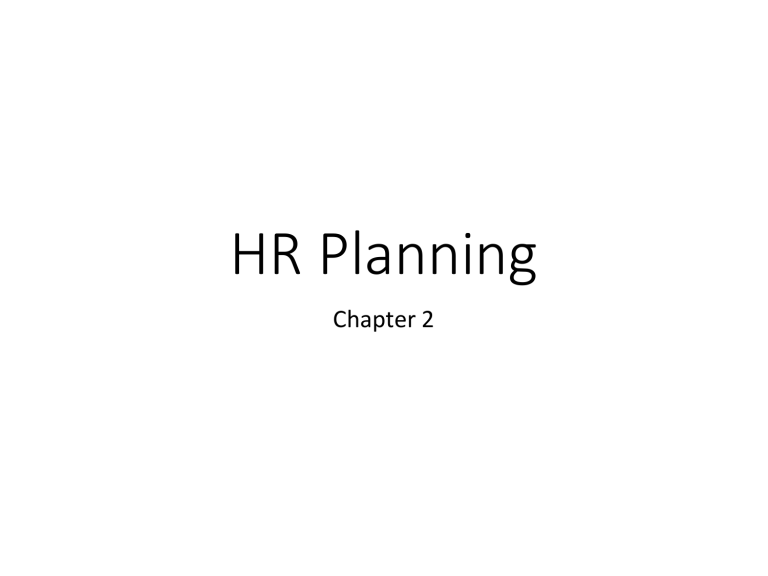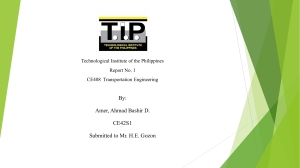
HR Planning Chapter 2 Overview • Effective HR Planning • Techniques to forecast demand • Techniques to forecast supply • Impact of Strategy Implemented HR Planning HR Planning: The process of anticipating and providing for the movement of people into, within, and out of an organization. Elements of Effective HR Planning 6. Monitor and Evaluate Results 5. Implement Plans to Balance Supply and Demand 4. Develop Strategy 3. Internal Analysis 2. External Analysis 1. Analyze HR Implications of Strategic Plans (Mission/Vision/Values) Step 1: Mission, Vision, and Values Mission • The basic purpose of the organization as well as its scope of operations Strategic Vision • A statement about where the company is headed and what it can become in the future; clarifies the long-term direction of the company and its strategic intent Core Values • The strong and enduring beliefs and principles that the company uses as a foundation for its decisions 1–5 Linking Strategic Planning and HRP Strategic Analysis • What human resources are needed and what are available? Strategic Formulation • What is required and necessary in support of the human resources strategy? Strategic Implementation • How will the human resources be allocated for structure, processes, and human capital decisions? Human Resources Planning Strategic Planning 1–6 Step 2: External Analysis Environmental Scanning • The systematic monitoring of the major external forces influencing the organization 1. Economic and ecological changes: general, regional, and global conditions 2. Technological changes: information technology and automation 3. Demographic changes and labour market trends: education, age, composition, literacy, immigration 4. Social changes: priorities toward work, childcare, eldercare 5. Legal and regulatory changes: laws and rulings 1–7 Step 3: Internal Analysis Culture Capabilities Internal Analysis Composition 1–8 Forecasting: A Critical Element of Planning Forecasting involves: • forecasting the demand for labour • forecasting the supply of labour • balancing supply and demand considerations 1–9 Forecasting Demand Quantitative Techniques (e.g., trend approach) Qualitative Techniques Managerial Judgment Forecasting Candidates: Supply External analysis • • • • general economic conditions national labour market conditions local labour market conditions occupational market conditions Internal Analysis • • • • • Skills / Management Inventories Replacement Charts and Summaries Computerized Information Systems Succession Planning Markov Analysis Step 4: Formulating Strategy Strategy Formulation • Moving from simple analysis to devising a coherent course of action SWOT Analysis • A comparison of strengths, weaknesses, opportunities, and threats for strategy formulation purposes • Using the strengths of the organization to capitalize on opportunities, counteract threats, and alleviate internal weaknesses 1–12 Business Strategy Value Creation • What the firm adds to a product or service by virtue of making it; the amount of benefits provided by the product or service once the costs of making it are subtracted (value = benefits − costs) Low-cost strategy: competing on productivity and efficiency – Keeping costs low to offer an attractive price to customers (relative to competitors) Differentiation strategy: competing on added value – Involves providing something unique and distinctive to customers that they value 1–13 Business Strategy Functional Strategy: Ensuring Alignment Vertical Fit/Alignment – Focuses on the connection between the business objectives and the major initiatives in HR Horizontal Fit/Alignment – Aligning HR practices with one another internally to establish a configuration that is mutually reinforcing 1–14 Step 5: Strategy Implementation Taking Action: Reconciling Supply and Demand Balancing demand and supply considerations – Forecasting business activities (trends) – Locating applicants Organizational downsizing, outsourcing, offshoring – Reducing “head count” Making layoff decisions – Seniority or performance? – Collective agreements 1–15 Step 6: Evaluation and Assessment Evaluation and Assessment Issues Benchmarking: The process of comparing the organization’s processes and practices to those of other companies Human capital metrics – Assess aspects of the workforce HR metrics – Assess the performance of the HR function itself Balanced Scorecard (BSC): • financial • customer • processes • learning 1–16









